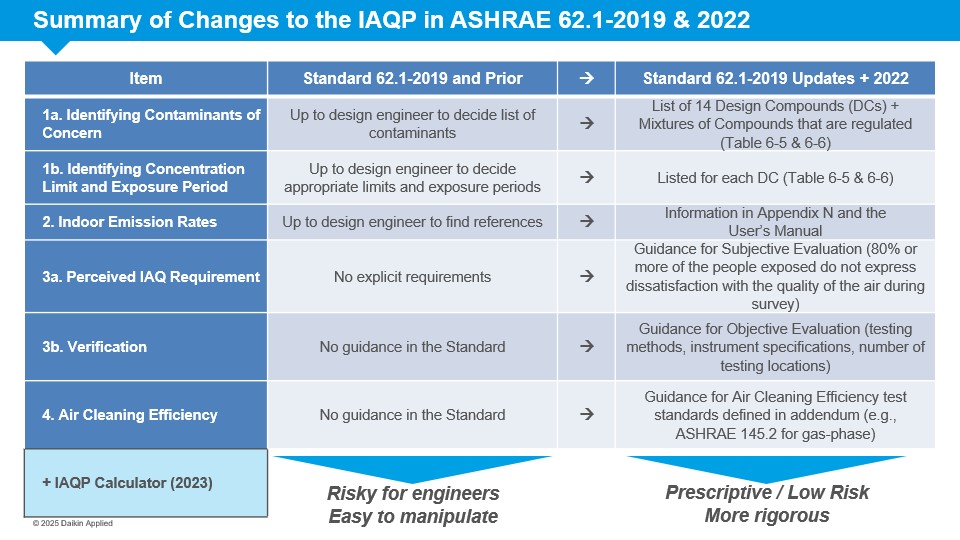A FRESH LOOK AT AIR QUALITY: IAQP AND THE EVOLUTION OF VENTILATION
For many centuries since, the only means of ventilating buildings was to open windows to let outside air in. Even today, the primary method of improving indoor air quality (IAQ) is by introducing outdoor air in prescribed volumes through mechanical systems.
This will ensure the spaces we occupy are healthy and comfortable. But it also promises to bring myriad benefits across sustainability, efficiency and cost.
VENTILATION VS EFFICIENCY
Despite advances in medicine and the understanding of indoor chemistry, the main approach to improving air quality has long been through outdoor air dilution — mixing outdoor air with indoor air to reduce the level of pollutants.
In 1973, ASHRAE (or the American Society of Heating, Refrigerating and Air-Conditioning Engineers) released ASHRAE Standard 62.1: Ventilation and Acceptable Indoor Air Quality, which contained minimum and recommended ventilation rates for more than 100 space types. Prescribed outdoor air rates, determined using the Ventilation Rate Procedure (VRP), based on area and occupancy, became the recognized standard for ventilation system design and this remains the most commonly used method of calculating ventilation rates today.
However, the method forces a choice between ventilation or energy efficiency. Think about aquariums: these are maintained through filtration, partial water changes and periodic testing to help keep the water clean. They aren’t constantly flushed and replaced with fresh water — so why are we still doing this with buildings?
.gif?sfvrsn=45084f72_1)
A NEW APPROACH TO IAQ
The 1980s updates to Standard 62.1 also introduced an alternative way to calculate ventilation rates, called the Indoor Air Quality Procedure (IAQP). This considered occupant comfort as well as the need to understand and control indoor pollutants through air cleaning equipment.
However, many factors were not clearly defined, which put much of the responsibility for working out how to implement IAQP on engineers and designers. The combination of the risk and effort this created ultimately limited adoption.

Emphasis on measuring and controlling IAQ nevertheless continued to grow, including into and through the 2000s with voluntary building certifications such as LEED (from the US Green Building Council), WELL (International WELL Building Institute) and Fitwel (Center for Active Design).
Then the COVID-19 pandemic brought increased attention to IAQ and ventilation — particularly air cleaning technologies, including filtration, adsorption, ionization and photocatalytic oxidation.
To meet the moment, ASHRAE made significant updates to Standard 62.1 IAQP between 2019 and 2023, introducing specific guidance and a calculator tool for engineers that made it practical to implement IAQP as a viable alternative to VRP. These updates are summarized in the chart, below.

SIGNIFICANT ENERGY EFFICIENCY GAINS
This was a paradigm shift — and IAQP brings ventilation into the 21st century.
Instead of setting fixed outdoor airflow rates based on the type of space and occupancy (measured in cubic feet per minute), IAQP focuses on clean airflow rates, also expressed as equivalent Air Changes per Hour (eACH). It moves calculating ventilation from a prescriptive approach to one that is performance-based and factors in indoor emissions rates and air cleaning alongside outdoor air rates.

This concept — cleaning the air first and then addressing any remaining contaminants via dilution with outdoor air — can help building designers and owners improve efficiency, lower cost and reduce carbon emissions in their buildings. It’s estimated that, in the US, applying the IAQP could reduce ventilation rates by 40-60% and reduce total building energy usage by 6-10%

Modern knowledge and new innovations are helping to advance this switch. Daikin, for example, has developed air-handling equipment that uses
Sorbent Ventilation Technology (SVT) from enVerid to control and manage indoor contaminants including
volatile organic compounds (VOCs) such as formaldehyde. VOCs can be emitted from a wide range of products including paints, cleaning supplies and building materials and concentrations can be up to 10 times higher indoors than outdoors.
Sorbent filtration captures such pollutants while allowing oxygen and water to pass through freely, resulting in cleaner air. Daikin’s systems with SVT can reduce outside ventilation by up to 60%, helping to control comfort levels while cutting operating expenses by up to 30%.
AN OPPORTUNITY THAT SPANS SECTORS
As rules around buildings' emissions tighten across the globe, there is much potential for ventilation systems to be assessed and optimized across new projects and existing structures. ASHRAE’s Indoor Air Quality Procedure not only enables decarbonization efforts, which translates into operational savings, but also produces resilient and healthier indoor spaces.
The time is now for building owners to invest in ventilation’s smarter, cleaner and more efficient future.